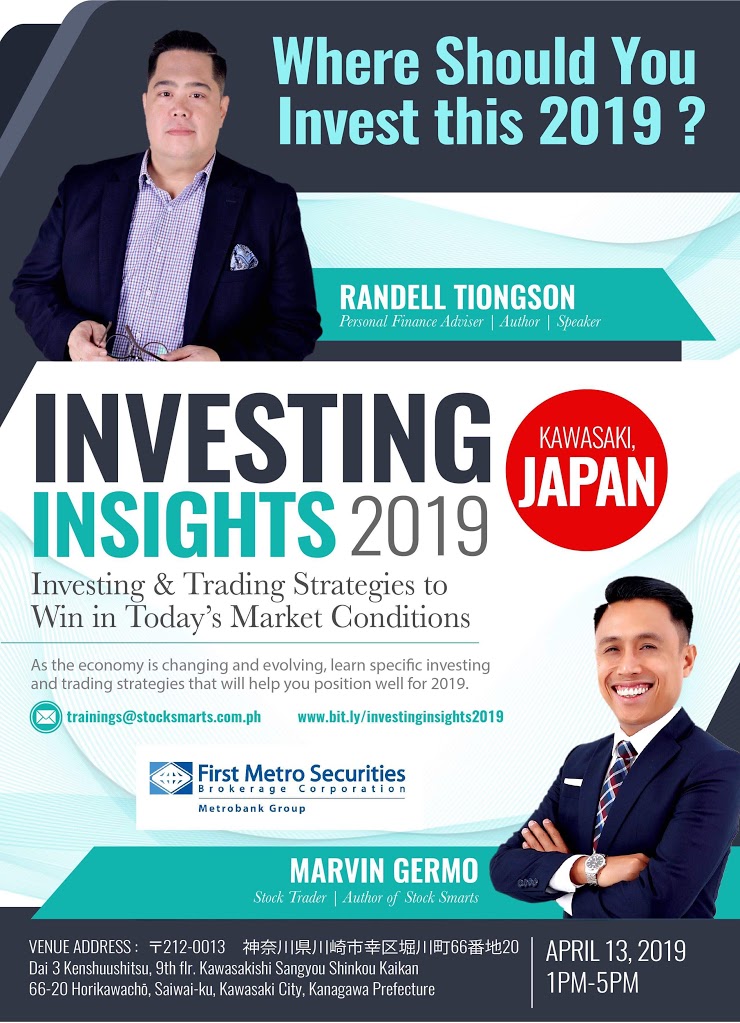I am now ready to invest
By Randell Tiongson on February 9th, 2019Question: I have been a reader of your column and blogs and I learned much from it. I am now debt free and have some emergency funds and savings and I am now ready to invest. Where should I put my money? – Name withheld upon request, asked via e-mail
Answer:
Congratulations for being disciplined enough to be debt free, establish your emergency funds and consider investing – you are on your way to achieve financial peace!
I am sorry that I can’t give you a specific answer as to where you can invest your hard earned money as I will need to further understand your situation before I can make any recommendation. I can however give you some broad guidelines, which I hope can help you arrive into a more informed decision.
You mentioned emergency funds and savings for investing so I will try to give you my thoughts for both.
As to emergency fund, I do not recommend that you invest that as the purpose of this money is for funding against life’s emergencies. Whenever you invest money, there is always the risk of some capital loss and there will be some form of liquidity risk involved, as you may not be able to immediately convert the investment into cash. It is best to keep emergency funds into cash or near cash instruments such as time deposits and treasury bills. If you are still keen on investing your emergency fund, you may opt to put some of it in very low risk investment instruments like UITFs or mutual funds invested in the money market or bonds. Obviously, you can’t expect much return even for those funds but I suppose it’s better than what you can get from savings and time deposits. I recommend that you should only invest a maximum of 50% of your emergency funds in the instruments I mentioned and the rest should be in cash for easy access.
As to your savings on top of your emergency fund, you should consider a few things before letting go of your money. In my book, the No Nonsense Personal Finance: A Step by Step Guide, I outlined some basic guidelines:
Know you investment objective: Before you do anything with your hard-earned money, I would recommend that you first consider what your investment objective is. I often tell people that our objectives will determine nearly every action we make with regards to finance. It is crucial that you first determine the reason for the investment. What is the investment intended for? What do you wish to achieve in making such an investment? Is it for retirement, future education needs of your children, purchase of an asset, or a general fund? Knowing what your objectives are will help you choose the appropriate investment for you.
To simplify objectives, categorize the general purposes of your investments according to the results in capital growth, income generation, or both. Certain investments will yield according to your desired purpose. For instance, people buy real estate properties because of capital appreciation while some people buy them for income purposes.
Know your risk tolerance – Risk and return are two correlating factors that you must always keep in mind when investing. Some people focus too much on returns and forget about risks, while others just look at risks at the expense of returns.
Here’s a very basic principle in investing — returns will always be a function of the risks you are willing to take. The risk-return relationship is simple and yet it is fundamental. The higher the potential yields are, the higher the risks will be; the lower the risks are, the lower the yields will be as well. No amount of financial engineering can change the fundamental fact of the risk and return relationship. Determine if you are a conservative, moderate or aggressive investor. If you are a conservative investor, it is wise for you to stay away from risky investments like stocks, lest you will experience a lot of sleepless nights when markets go south.
Know your time frame – When will you need the bulk of your investments? Are you investing your money just to park it while waiting for big-ticket items such as tuition or the proper investment? Or are you investing with a long-term goal of 10 years in mind? There are short term, medium term, and long-term objectives, and there are corresponding short, medium, and long-term instruments for such. It is unwise to use short-term instruments such as time deposits or Treasury bills (T-Bills) for long term investments like retirement, education, and anything that has more than a three-year life span, as you will lose on inflation. On the other hand, you should not use medium or long-term instruments such as pooled funds (Unit Investment Trust Funds or mutual funds), equities, or variable universal life insurance for short-term objectives where you will need the funds in one year or less; you run the risk of capital loss. Emergency funds are considered short-term objectives and must only be invested in short-term and very liquid instruments.
Take time to learn more about proper investing by reading books, articles and blogs, attending seminars and go ask around from as many people as you can. Investing is not rocket science and a little effort can really help you make prudent decisions in making your money grow.
For our dear Filipinos abroad, you catch me at the following areas for my seminars: Dubai & Tokyo.





I’m in my mid 50s and I only have about PHP 1M saved up. I’m really worried about my retirement. Would it be advisable if I put the money in stock market and put 50% low risk and 50% high risk. If not advisable, would appreciate your help if you could guide me as to how to invest my saved money properly? Thank you very much in advance and have a pleasant week ahead!